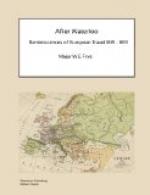Suza is a tolerably large town and has a neat appearance. It is commanded and defended by the fort of Brunetti, now dismantled, but which is to be repaired according to the treaty of 1815. It will then be a very important post and completely barr the pass of Suza. The road from Suza to Rivoli is thro’ a valley widening at every step; at Rivoli you debouche at once from the gorge of the mountain into a boundless plain. The road is then on a magnificent chaussee the whole way to Turin, and every vegetable production announces a change of climate to those coming from Savoy. Here are fields of wheat, indian corn, mulberry and elm trees and vines hung in festoons from tree to tree, which give a most picturesque appearance to the landscape, and, together with the country houses, serve as a relief to the boundless plain. The chaussee is lined with trees on each side the whole way from Rivoli to Turin; I observed among carriages of all sorts small cars, like those used by children, drawn by dogs. These cars contain one person each. They are frequent in this part of the country, and such a conveyance is called a cagnolino. The Convent of St Michael, situated on an immense height to the right of the road between Suza and Rivoli, is a very striking object. The mountain forms a single cone and it appears impossible to reach the summit except on the back of a Hippogriff:
E ben appar che d’animal ch’abbia
ale
Sia questa stanza nido o tana propria.[75]
The castle seemed the very neat and lair
Of animal, supplied with plume and quill.
—Trans. W.S. ROSE.
TURIN, 14 August.
Turin is a large, extremely fine and regular city, with all the streets built at right angles. The shops are very brilliant; the two Places, the Piazza del Castello and the Piazza di San Carlo, are very spacious and striking, and there are arcades on each side of the quadrangle formed by them. The Contrada del Po (for in Turin the streets are called Contrade) leads down to the Po, and is one of the best streets in Turin. Over the Po is a superb bridge built by Napoleon. In the centre of the Piazza del Castello stands the Royal Palace, and on one side of the Piazza the Grand Opera house. The streets in Turin are kept clean by sluices. The favorite promenades are, during the day, under the arcades of the Piazza del Castello and those of the Contrada del Po; and in the evening round the ramparts of the city, or rather on the site where the ramparts stood. The French, on blowing up the ramparts, laid out the space occupied by them in walks aligned by trees. The fortifications of the citadel were likewise destroyed.
In the Cathedral Church here the most remarkable thing is the Chapelle du Saint Suaire (holy winding sheet). It is of a circular form, is inlaid with black marble and admits scarce any light; so that it has more the appearance of a Mausoleum than of a Chapel. It reminded me of the Palace of Tears in the Arabian Nights.




